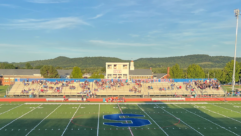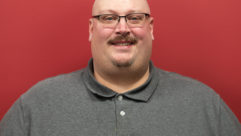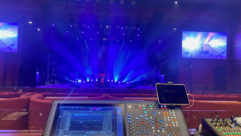Service, with a Smile
Oct 1, 2003 12:00 PM,
Gary Eskow
Every year millions of American families head to theme parks searching for a few days, or maybe just a few hours, of rides, relaxation, and a respite from the hassles of everyday life. How important is the audio component of this experience? Who makes sure that failures in this area are rare and immediately attended to when they do occur?
Maintenance is handled in different ways. On-site staff can be responsible for this entire operation at one park, and another may outsource this responsibility entirely. In order to get an overview of this business, Sound & Video Contractor convened a panel of experts that includes a top sound designer, several on-premise managers, and an independent contractor. Their thoughts on the importance of designing and maintaining audio should help anyone who is considering entering this industry.
Howard Schlieper is the director of the entertainment solutions group at A. F. Associates, a worldwide leader in technology consulting, engineering, and systems integration. Schlieper has worked on a number of highly visible projects over the years, including the Experience Music Project in Seattle, Terminator T2/3D, Waterworld, many Hard Rock Café installations, and the Kennedy Space Center Visitors Complex at Cape Canaveral.
John Lyle, manager of technical services at Cedar Point Amusement Park in Sandusky, Ohio, is responsible for sound on all of the rides and games as well as the background music that plays throughout the park. Cedar Point is owned by Cedar Fair, L.P., a publicly traded partnership that owns and operates six amusement parks and five water parks.
Gary Liest, sales manager at Entertainment Arts (EA), spends two days each week at Universal Studios in Orlando, Florida, making sure that the audio components his company has installed for the rides and attractions are functioning smoothly. In 1989 Tim Huff and Dan Franklin started up Entertainment Arts. The company was incorporated in 1991 and now includes seven associates. EA currently is a dealership that represents more than 100 manufacturers.
James Judy, director of operations at Raging Waters in San Jose, California, virtually grew up in the theme park industry, starting out with part-time jobs while still in high school. Raging Waters is owned by the Palace Entertainment Group, which operates nine water parks and 27 family entertainment centers throughout the United States.
S&VC: How does a company go about securing a maintenance contract for audio at theme parks? Obviously, those parks that handle these functions in house have a different set of needs from those that rely on outside vendors exclusively to handle these needs. How do you view the bidding process?
Howard Schlieper: We get work in a variety of ways, from word of mouth to building upon established relationships to going out there and investigating opportunities in an attempt to get on a bidder’s list.
Theme parks typically have a trusted group of people whose work they know, but bids do go out that allow other companies into the process. There generally is a preapproval, or qualifying process, that each prospective bidder has to go through, where you establish that you are able to handle all of the elements that go into the job. I’m speaking primarily of the design component of a job, but for us, at least, maintenance flows out of our design work.
Once we’ve been prequalified and placed on the bidder’s list, we want to learn everything we can about a job — that’s step one. Secondly, we try to be competitive pricewise. Finally, we think long and hard about whether there are hidden improvements we can make to the design of a job as it’s been presented to us.
Maintenance is a critical part of the process. In my experience, many design companies fall on their face when planning for it. They often seem to put all of their energy into getting to the finishing line — the completed install, in one piece — that they miss out one of the key things that a properly outlined maintenance plan can give you: cementing the relationship with the client. If you’ve just spent two-and-a-half years on an installation, the last thing you want to do is disappear when it’s complete.
John Lyle: Because we’re the in-house company, no bidding is involved in any of the work we do. Our department is responsible for all of the engineering as well as figuring out what the park needs in terms of audio.
From our point of view, because we run for about 130 days each year and our equipment is on 24/7, once we’ve designed our audio, the most important part of our job is picking equipment that can perform well under stress. We rely heavily on Crown amps, because over the years, we’ve found them to be durable and extremely flexible.
Choosing the right speakers is very important to us. We don’t want to be fixing tweeters or swapping out speakers on a regular basis. We use SoundTube Entertainment products throughout the park. Again, from our perspective, a key aspect of maintenance is making sure that you select the right equipment in the first place.
Gary Liest: The theme park business is extremely competitive. You have to be very smart in the bidding phase and remain competitive once a job has been secured. For example, our contract with Universal Studios states that it can shop every equipment order to three different bidders. If it finds a lower price than ours, we must match it or go.
Our relationship with Universal Studios came about by word of mouth. We’ve been working with it for two-and-a-half years but have had a contract for only the past six months or so. Prior to that, we were working on a trial basis. The vendor it had been using went under — caught, I believe, in the profit-margin-versus-client-demands squeeze.
We won our contract based on our service, particularly in the commitment we were willing to make in the area of customer care. We clearly laid out in our proposal the fact that we planned on being on-site twice a week, and that clearly helped us. Other companies didn’t want to spend the amount of time at the park that we were willing to invest.
The contract Entertainments Arts signed gives us about 90 percent of Universal Studios’ audio needs and about 5 percent of its video work. Prior to the contract, we had actually been servicing more of its video needs, and we are working on taking the rest of it back. Our video equipment bid was higher than others, and we didn’t have relationships with the dealerships it had been using. So we’re focusing on building relationships with more dealerships, and we will soon have more brands available to us.
James Judy: As far as equipment goes, we have almost all of the original gear that we purchased 10 or 12 years ago, and that includes our wiring design work. We added a satellite music system six or seven years ago, but changing speakers is about all we’ve had to do from time to time, and there is no bidding process that we go through.
S&VC: Every major theme park has some staff on premise that helps handle equipment maintenance. Howard mentioned that outside vendors sometimes miss an opportunity by not developing a strong relationship with these people. Gary, does your company place as high a value on these kinds of relationships?
Liest: Absolutely. Long after a job is complete, we continue our relationship through follow-up calls and visits. We also provide on-site training to anyone who is interested. Our way of thinking when we go into an install job is to treat the project as if it were our own house. If we would not like a piece of equipment or aesthetic choice in our house, then we won’t put that gear or make that decision in a theme park, a church, or any of the other clients’ facilities that we serve.
S&VC: Are there other technologies that you find yourselves relying on these days?
Schlieper: I can think of four critical areas:
- Multichannel power amplifiers. Certain manufacturers, such as Crown and QSC, have been offering as many as eight channels of flexible, high-quality, sufficient power in the same amount of rackspace as what two channels of amplification used to require. That greatly reduces the amount of rackspace required for power amplifiers in large systems. Rack room real estate is always precious and often hard to get enough of, so reducing the amount of rackspace required for a system is a very good thing.
- Audio DSP. Many manufacturers, including Architectural Acoustics and BSS, offer high-quality digital signal processors in a variety of configurations. These are very flexible devices and allow easy control and precise tailoring of the exact virtual components required for the specific needs of each area of the audio system. These devices often reduce the number of separate boxes or components required in the system. The equivalent of a whole rack of outboard processors can reside virtually inside a single rackspace unit. I often consider the right DSP box as the Swiss army knife of audio processing for fixed installation. If changes or updates are required as the audio system is being designed, programmed, installed, or commissioned, often it is as simple as reconfiguring the software program within the unit rather than rewiring or adding external devices. For example, if an additional compressor/limiter or parametric equalizer is required or if some routing change pops up, it’s usually as simple as adding or changing the device from the menu of onboard devices and/or rewiring it virtually within the system software. These are also easy to control via the show control system. Presets can be configured easily within the software, and the control system can simply access these presets as desired via serial connection or contact closures as appropriate.
- Cobra Net audio distribution. Cobra Net distribution is convenient for sending multiple channels of audio over long distances via Cat-5 cable or fiber. This greatly reduces the amount of cable required to distribute audio over, say, an entire theme park or a large building. Cobra Net technology is often incorporated into the digital signal-processing devices and even some of the amplifiers themselves. This can allow for the distribution of the audio signal from the output of the signal processors all the way to the input of the amplifiers while staying in the digital domain.
- Amplifier processing. More and more amplifiers are able to have onboard signal processing at the amplifier itself. This can be a great feature allowing you the option of distributing the processing to each part of the system as desired. These processing cards in the amplifiers are usually able to be networked together for easy communication and adjustments.
Liest: With speaker brands ranging from Apogee to Tannoy, projectors like Barco and Sharp, and interfacing with Crown IQ to Peavey MediaMatrix, Universal has got it all. It has been around the block when it comes to finding the sound and feel it is looking for, and it is proud of the finished product. Guests leave with a pleasing audio and visual experience and remember their trip to Universal Studios, Orlando.
S&VC: Do any of the locations you serve have wiring issues that are problematic now or that you anticipate to be in the future?
Judy: With the exception of Dragon’s Den, the new ride we added recently, all of the wiring at Raging Waters is from the original design work. Unfortunately, plans for these designs were not cataloged properly, and so we may have a problem in the future. A lot of our waterslides feed from the top of a large hill. Wiring goes up to the top of the hill, but no one knows how it gets there.
Dragon’s Den, for example, is a large, fiberglass-bowl-type of slide; the bowl itself is 30 feet in diameter. This ride is heavily themed, with a 10-foot-tall dragon that sprays water in the bowl and speakers underneath that play sound effects. We put in a self-contained sound system for this ride and used several different SoundTube models underneath the bowl.
S&VC: Finally, how important is audio to the total effect that people experience when they come to a theme park?
Schlieper: Audio is tremendously important. It is, after all, a major part of the entertainment experience throughout our culture today, from laptops playing MP3 tracks to home-theater systems. Theme park attractions that have an intense theater experience need to have outstanding audio, and the same holds true for rides that have sound effects.
Audio at a theme park is, in my view, on a higher level than many others, because the goal is not just high-quality sound. You’re trying to immerse the guests so that when they walk out of the park, they feel they’ve gotten a one-in-a-million experience. You want to give them something they can’t get in their home.
Judy: Sound is very important to the park, as critical as our landscaping or painting. In a water park, you’ll typically have a lot of parents coming with kids. The adults often like to hang out in our lounge while the kids enjoy the rides. It’s critical that we have background music and a sound system that will be attractive to them.
A composer as well as journalist,Gary Eskowis completing a string quartet, the Amazing X-Ray Machine. Examples of his work may be downloaded at his Web site,www.garyeskow.com.










